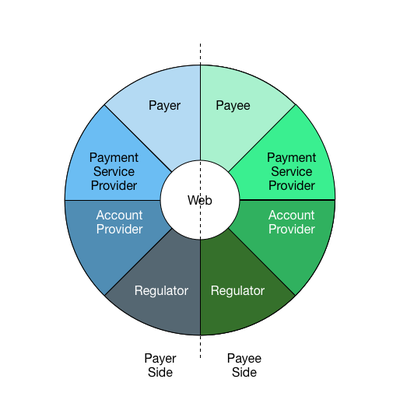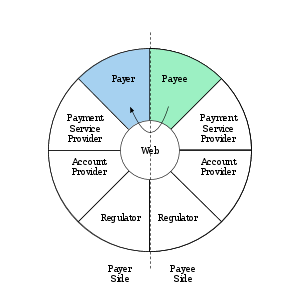Warning:
This wiki has been archived and is now read-only.
Main Page/FTF June2015/Capabilities
From Web Commerce Interest Group
< Main Page | FTF June2015
Contents
Goals
- Shared understanding of how these capabiltiies relate to needed working groups and charters
- Identification of any additional capabilities needed to fulfill roadmap
- Consensus on organization of capabilities
For Discussion
- Web Payments Capabilities
- Key rationale and for how these capabilities are organized
- Incremental approach to capablities (Now and Next) and relationship to charters
Not for this discussion
- Prioritization (that happens after this session)
- The order of specific capabilities beyond initial grouping
- Specific fine grained features (unless needed to discuss broad capability gaps)
Web Payments Capabilities: Where are we now?
Five Course Grained Groups of Capabilities
- Core and Security - Includes: Key Creation and Management, Cryptographic Signatures, Encryption
- Identity and Credentials - Includes: Identity, Credentials, Rights, Authentication, Authorization, Privacy, Discovery, Registration, Enrollment, and Legal/Regulatory concerns
- Accounts and Settlement - Includes: Accounts, Ledgers, and Legal/Regulatory concerns related to accounting and recorded ownership.
- Payments and Exchange - Includes: Payment, Messaging, Clearing, Markets, Foreign/Currency Exchange, and Legal/regulatory concerns specific to Payments and Exchange of Value.
- Commerce - Includes: Offers, Invoicing, Receipts, Loyalty, Rewards, Contracts, Lending, Insurance, Taxation, Legal/Regulatory concerns related to aspects of commercial and economic interactions
Why did we organize capabilities in this way
- Web payments standards are intricately linked to other web interactions used outside of payment process (ex. trust, commerce and account management)
- Groupings allow for coordinated yet de-coupled implementation of standards
- Provides consistent way of grouping IG requirements and work over multiple standards versions
- Allows for foundational capabilities and interactions that are broader than payments (such as Credentials and Commerce) to incorporate features that are needed for interoperability between payments and non-payments work
- Facilitates discussion of standards using discrete interactions between roles
Now and Next: Base-lining capabilities and Capability evolution
- As mentioned earlier, by organizing capabilities into consistent groups, chartered working groups will be able to proceed on initial standards versions while IG continues work on requirements for subsequent versions.
- Also allows for loose-coupling between payments and related working groups and standards bodies
- NOTE: Focus for this meeting is to ensure that features needed to meet initial use cases and goals are captured (the "now" features)
- Groupings serve as a place to capture additional needs ("next" features) and can also be quickly captured without slowing work on immediate needs
Payments interactions
- Payments (and interconnected capabilties) can be expressed as a series of discrete interactions between two parties.
- Interactions may involve many different parties which play different roles at different times
- A payment interaction may involve just two parties (e.g., peer-to-peer) or more complex interactions may involve several collaborating parties.
- These interactions may happen in different sequences and direction depending on the payment context.
Example Interactions
| Interaction 1: Payee presents request for payment to Payer with necessary payment end point details | Interaction 2: Payer connects to Payment Service Provider and intiaties Payment using provided details | Interaction 3: Payers Payment Service Provider completes payment to specific Payment End Point and sends confirmation of payment to Payee's Payment Service provider |
Questions
- Are there any capabilities required for the now use cases that don't fit cleanly into this approach?
- Are there any capabilities that are missing relative to our stated goals?
- Is there agreement on the approach and initial set of capabilities needing standardization?
.svg/400px-CapabilityGroups(H).svg.png)



